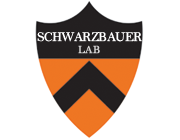The extracellular matrix is an essential protein network that provides specific environmental signals to control cell organization and function in all tissues. Deficiencies in matrix composition and architecture contribute to many diseases including cancer, atherosclerosis, arthritis, and skeletal defects. The overall goal of our research is to determine how tissue-specific variations in matrix structure and organization regulate and modulate cell activities.
One of the major components of extracellular matrix is fibronectin, a large, adhesive glycoprotein. Fibronectin interacts with cells and transmits signals primarily through integrin receptors. Integrins are a large family of a b heterodimeric receptors with specificity for extracellular ligands. Integrin recognition of fibronectin promotes cell adhesion, migration, and proliferation. Integrins are also essential for assembly of fibronectin into a pericellular fibrillar matrix. Blockade of intracellular pathways with specific kinase inhibitors and analyses of cells that lack various signaling molecules have revealed essential roles for focal adhesion kinase (FAK) and Src kinase, syndecan proteoglycan receptors, and a sulfate transporter in this cell-mediated assembly process. FRET analyses performed with GFP-tagged fibronectin domains are providing new insights into conformational changes that occur during matrix assembly.
The fibrillar fibronectin matrix provides a unique environment for studying how cells respond to changes in matrix composition and organization. We have found that this three-dimensional (3D) network promotes increased integrin activity leading to stimulation of matrix assembly. By varying the cell binding capacity of the matrix by incorporating mutant fibronectins, we have been able to tailor the matrix microenvironment to favor migration of cells with specific integrin repertoires. We are now using this system as a physiological substrate for characterizing regulation of stem cell self-renewal and differentiation.
A highly dynamic matrix composed of fibrin and fibronectin is formed at sites of tissue injury. This wound provisional matrix provides a useful model for determining the matrix requirements during injury repair. Our results show that fibroblasts adhere and spread on this matrix and activate FAK and Rho GTPase in a fibronectin-dependent manner. Tenascin-C, another matrix protein that is up-regulated at injury sites, modifies cell binding to this matrix, induces extension of lamellipodia, suppresses Rho activation and has these effects by preventing syndecan receptor binding to fibronectin. We are continuing to use this 3D matrix to define the roles of matrix composition in modulation of cell adhesion and signaling.
The laminin-rich Matrigel reconstituted basement membrane matrix is a key substrate for differentiation of mammary epithelial cells into spherical duct-like structures in culture. This matrix promotes polarization of cell clusters, growth arrest, and formation of a hollow lumen by apoptosis of cells not contacting the basement membrane. Fibronectin levels are increased in breast tumor stroma so we are testing the effects by addition of fibronectin to the Matrigel matrix. We have found that fibronectin reverses growth arrest, promotes proliferation, and perturbs acinar morphology, suggesting that up-regulation of fibronectin in tumors contributes to the oncogenic phenotype.
Integrin receptors are structurally and functionally conserved in all multicellular organisms. We have established a genetic system based on the nematode Caenorhabditis elegans to determine the primary pathways involved in transmission of extracellular matrix-integrin signals. Integrins are required for post-embryonic gonad morphogenesis which depends on directed migration of two distal tip cells. Both genetic and genome-wide RNAi-based screens for defects in this cell migration process have been used to identify genes that regulate integrin-mediated cell migrations in vivo. Ninety-nine genes have been identified as essential for distal tip cell migration and gonadogenesis. We are focusing on a subset of these genes that show phenotypes specific for initiation of migration, cell turning, or stopping.
To complement these rather complex nematode and cell culture systems, we are also collaborating with Prof. Jeff Schwartz in the Chemistry department to develop chemically-modified substrates with defined compositions of adhesion protein domains. Materials such as titanium, silicon, and nylon have proven amenable to modification and have already been used to generate cell adhesive surfaces. In addition, we are exploring the potential use of these modified materials as implants for tissue repair and regeneration.

